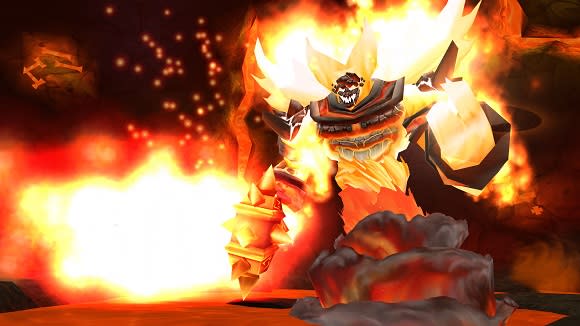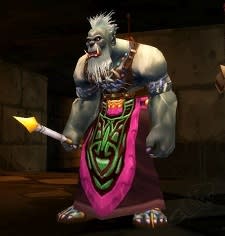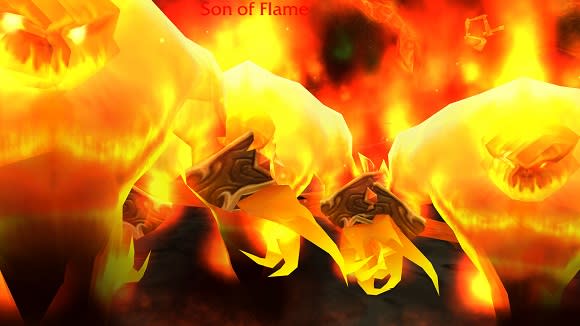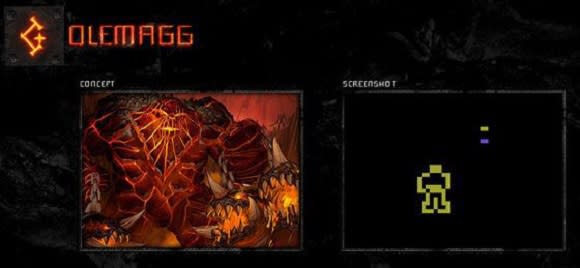WoW Archivist: The classic Molten Core experience, part 3

WoW Archivist explores the secrets of World of Warcraft's past. What did the game look like years ago? Who is etched into WoW's history? What secrets does the game still hold?
If you missed part 1 and part 2, that means you were late for the raid and we're docking you 50 DKP. Next time get here early to help the warlocks farm soul shards.
OK, fellow archivists! We've cleared trash, we've decursed, we've pulled Geddon to Garr's room, we've brefriended the Duke, and we've doused every fiery rune. It's time to delve into the core of the Core to take on the Majordomo and Ragnaros himself, 2005 edition.
The invincible majordomo
Undefeated in battle, Executus rose through the ranks of Ragnaros's lieutenants to become the Firelord's majordomo. He did not appear until you doused all the runes, so the earliest raids on Molten Core had to stop after Golemagg and Sulfuron due to an Aqual Quintessence shortage.
After raiders repped up with the Hydraxian Waterlords and could finally summon the Majordomo, they were faced with an invincible warrior -- literally. Executus could not be killed. His Aegis of Ragnaros spell gave him a 30K damage absorb buff and healed him to full, so it was pointless to DPS him.
Instead, raids had to manage his eight adds: four Flamewaker Elites and four Flamewaker Healers. Mages were the key to this fight as they had the only reliable, long-term crowd control spell for humanoids. The fight required at least five tanks, one for the majordomo and one for each elite. All four healers were sheeped until all the elites were dead. Then the raid could kill the healers one at a time.
But it wasn't that simple. The fight had some interesting complications.
Executus gave two types of shield buffs to all of his allies. Purple shields reflected melee damage, so melee had to stop hitting these adds. White shields had a 50% chance to reflect a spell, so casters had to back off lest their nukes rebound. Hilariously, mages could sheep themselves if they weren't careful when locking down the healers.
The pull was the most difficult part of the fight. Most raids pulled with a bubbled paladin or ice-blocked mage to keep the nine enemies busy while the sheeping was accomplished and the five tanks taunted their assignments. Meanwhile, the healers had to refrain from throwing out the smallest HoT tick, or all the aggro would come their way.
Executus himself could Teleport anyone into the "burning coals" pit at the center of his area. This would drop aggro for a tank. In a world without Misdirection or Tricks of the Trade, the tank had to reestablish aggro on the boss/add before it started slapping around healers. Some raids brought a sixth tank just to pick up loose adds.

Once you killed all of the majordomo's subordinates, he surrendered and offered up a cache of treasure. This included the famous caster weapon Finkle's Lava Dredger, the item to start the hunter quest line for Rhok'delar, and the item to start the priest quest line for Benediction/Anathema.
Outside of legendaries, the Ancient Petrified Leaf and The Eye of Divinity were the two most coveted items in the entire zone. You weren't just looting an item -- you were looting an experience. As someone who earned his Rhok'delar in classic, I can tell you that few quest lines in WoW made you feel like you had truly mastered your class like this one did for hunters. I haven't wielded a weapon since that made me as proud as my Rhok.
Fireable offense
With Executus slinking off in shame, you could now engage Ragnaros himself. "Imprudent whelps!" Executus called you, when you asked him to summon the Firelord. He was pretty psyched about it, though. "Bow before him, mortals!" he said. "Bow before your ending!"
Of course, his glee turned to dismay when Ragnaros didn't reciprocate the majordomo's enthusiasm at their reunion. His infamous line "YOU HAVE AWAKENED ME TOO SOON, EXECUTUS!" has been an enduring meme ever since. Random trivia: After Executus was "fired," Ragnoros's HR department hired Fandral Staghelm as the new majordomo.
Words can't fully describe the feeling when you watched Ragnaros rise from the depths of the Elemental Plane to tower over your raid. He dwarfed even the largest bosses in Molten Core and made you feel that your small army of 40 players wasn't nearly enough. You were like insects to be stepped on. And that's exactly what he thinks of you: "NOW FOR YOU, INSECTS!" he said. "BOLDLY, YOU SOUGHT THE POWER OF RAGNAROS. NOW YOU SHALL SEE IT FIRSTHAND!"
You had 1 hour to kill him before he despawned for the rest of the week. (Patch 1.4 upped his despawn timer to 2 hours.)
Heavy resistance

In early 2005, Ragnaros was nigh-impossible to defeat unless a large portion of your raid had adequate fire resistance gear. FR helped on several fights in the zone, but for Ragnaros the resistance was essential. Resistance buffs like the druids' original Mark of the Wild and paladins'/shamans' Fire Resistance Aura/Totem weren't enough. This stat came mainly from armor. Many of the drops throughout the zone, including armor recipes, came with built-in fire resistance. For this fight, you needed every piece. Casters could get away with about a hundred fire resist, but tanks and melee needed two to three hundred.
Fire resistance potions for high-damage phases also came in handy. Many raids went through two or three FR potions per attempt. Multiplied by 40, every pull was a huge expense, which is why most raiding guilds had dedicated herb farmers.
One elaborate "cheat" helped many guilds get their first Ragnaros kill before they had all the FR gear they needed. In Blackrock Spire, a mob called Scarshield Spellbinder had an ability called Resist Fire. It buffed the target with 81 fire resist. If you had a priest to mind control them, you could give this buff to your own raiders.
You had to complete this laborious process prior to each attempt, of course, since dying removed the buff. It took a long time to cycle everyone through, so raid teams would buff everyone before summoning Ragnaros and starting his 1-hour timer. Despite the obscurity of the tactic, it was never considered an exploit by Blizzard. I'm not ashamed to say this is how my guild beat him the first time!
If you were resisting Rags, it was only fair that he resisted you. Like several other bosses in MC, Ragnaros was immune to fire damage. It made sense. He was, after all, a being of living fire. Classic enemies had many such "common sense" immunities. For example, spirit-type enemies couldn't bleed or be poisoned.
In Molten Core, mages suffered the most. So much fire immunity had been sprinkled throughout the zone that a fire spec was pointless there. Before the introduction of dual specialization, that meant raiding as a different spec for the entire first tier of WoW raiding, even if fire was your personal preference. Ragnaros remained immune to fire damage until patch 4.2 in 2011.
By fire be purged
After all the hype, Ragnaros's first phase was basically tank and spank. Lava splashed on the raid now and again and the damage could be resisted. Melee had to run out just before he cast Wrath of Ragnaros or take heavy damage and get knocked back anyway.
Ranged had to spread out around the outer circle because Hammer of Ragnaros was unavoidable and had an AOE effect. Anyone hit by it could get knocked into the lake of lava around his room. The geometry of the lake was unforgiving -- they were only a few places that allowed you to jump out. Disoriented casters often found themselves burning to death in the lava pit before they found an exit. But ranged DPS had the advantage that they couldn't pull aggro, since stationary Ragnaros preferred melee targets whenever one was available. Unlike melee, ranged could go all out with their damage.
If you want to know just how little regard Blizzard had for enhancement shamans and retribution paladins in classic WoW, look no farther than the Hammer of Ragnaros ability. It didn't target based on spec, but on whether or not the player had a mana bar. An enhancement shaman or ret pally would get the Hammer brought down on the entire melee group. They were completely nonviable for this fight.
Ragnaros also put a DOT on the tank, making swaps a good idea. Most annoying of all, he had a passive ability called Melt Weapon that would randomly do durability damage to any weapon that struck him. Like the fire immunity, it made sense for weapons to melt when hitting him. It's flavorful and appropriate. But it was also a big headache for tanks and melee.

This phase continued for 3 minutes. At that point, Ragnaros submerged and eight Sons of Flame came out of the lava. You had to collapse the raid into one area before this happened. The sons had an AOE mana burn ability, so keeping them away from healers was paramount. Warlocks could banish them, though it was not ideal, since it took a long time for them to unbanish. Ragnaros returned after 90 seconds whether all the sons were dead or not.
That was the entire fight. He alternated between phase 1 and phase 2 until he died -- or you did. Wipes usually occurred because too many tanks or healers died, or healers ran out of mana.
If you outlasted him and pushed the Firelord back to the Elemental Plane, you could expect some tasty loot. In addition to Tier 2 pants (the only Tier 2 gear in the zone), he had a chance to drop the Eye of Sulfuras. This was the key component to crafting Sulfuras, Hand of Ragnaros.
Shifting complexity
Ragnaros's sons were a unique mechanic in Molten Core. No other boss in the zone had adds that appeared during the fight. Think about that for a second. It's such a common occurrence today, it's hard to imagine that this was true, but that's how basic the encounters actually were.
The "skill" aspect of MC bosses mostly came down to making sure people had the correct assignments for tanking and healing, decursing debuffs as fast as possible, and managing some crazy first moments after the pull. During the fight, the biggest problems weren't often the mechanics but threat and mana management. DPS could generate way more threat than tanks, so damage dealers had to be disciplined in what abilities they used. Tanks had to hold threat any way they could. Anyone with a blue bar, not just healers, could go out of mana. Hunters were especially prone to the dreaded OOM. I went through many a mana potion in Molten Core, and I would sometimes Feign Death away from the fight just so I could sit down out of combat and drink.
Actual mechanics were slim and often had simple solutions. Whereas some of today's raid encounters require 20-minute videos and elaborate diagrams to explain, many MC boss strats can be summed up in a sentence or two. When people say the game has been dumbed down, I disagree. The complexity has been shifted from less exciting aspects like threat, mana, and roster headaches to more exciting aspects like actual encounter mechanics. Later raids in classic had more complicated bosses. Yet, even so, today's bosses are so much more complicated that we couldn't even have imagined them back in 2005.

Legacy of the core
Despite its simplicity, the Molten Core will always be special to classic WoW raiders. It was the place where we learned what our guilds were capable of, and what we as players were capable of. Triumph and tragedy played out on the biggest stage the game has ever had, with 40+ players' endgames at stake. MC had many aggravating design choices like the insane trash respawn timers and the rep grind just to access all the bosses. But those aspects are now part of the nostalgia. In terms of "epicness," Molten Core endures as a touchstone for what a raid should be.
In 2008, Blizzard unveiled the console version of Molten Core. The Atari 2600-style adventure featured all the original bosses, only missing a few million pixels. It was, of course, an April fools joke. One fan liked the idea so much that he created it.
Three years later, Cataclysm's Firelands raid was Blizzard's love letter to Molten Core, their chance to do it over again with modern sensibilities, to evoke the feel of the Core without all the hassle. They gave us new flamewakers, new corehounds, new elementals, and even a patrolling boss with Shannox. They remade Ragnaros into an absolute beast of a boss -- and gave him legs to boot.
It will be very interesting to see what Blizzard does with Molten Core for its 10-year-anniversary LFR version. Will today's players scoff at the old-schoolness of it all? Will veterans soak in the nostalgia or find disappointment at how the zone hasn't held up over the years? Either way, I can't wait to see a full raid window in a raid zone, blow up my friends with Geddon's bomb, and ride a core hound into the sunset.

After months of surveying, WoW Archivist has been dug back up! Discover lore and artifacts of WoW's past, including the Corrupted Blood plague, the Scepter of the Shifting Sands, and the mysterious Emerald Dream.
